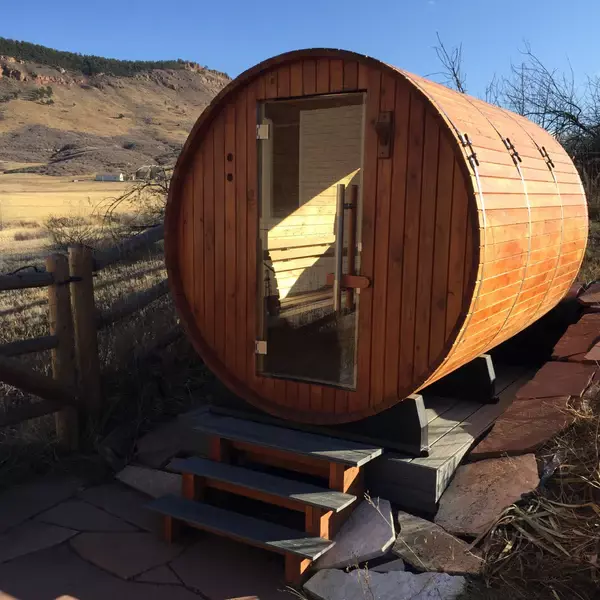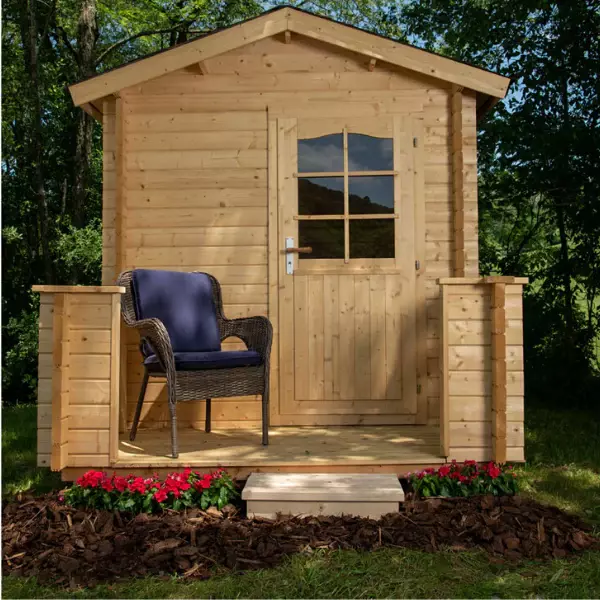Barrel Saunas vs. Cabin Saunas: Differences & Similarities
Saunas have come a long way from their simple, fire-heated origins in ancient Finland. Originally just small caves aimed at boosting well-being, today’s saunas have morphed into sleek urban cabins of varying shapes and sizes. Whether they’re old or new, one constant remains: their commitment to enhancing physical and mental health.
Every premium sauna delivers a slew of health advantages, yet the design of the sauna can shape how you reap these benefits. Remember, sauna therapy isn’t only about the endpoint—those health benefits—but also the journey, including the ambiance and experience it offers.
In this guide, we’ll dive into the key differences between two popular sauna styles: the barrel sauna, which seamlessly blends with outdoor settings, and the classic cabin sauna, a rectangular design versatile enough for both indoor and outdoor setups.
Let’s Compare Barrel Sauna Design Vs. Cabin Saunas
You’d be surprised to learn that there are some important differences between barrel and cabin saunas. We categorize these based on ambiance, design, insulation, installation, maintenance, and price.
Design
Although both cabin and barrel saunas are made of wood, their design influences certain micro experiences within the sauna.
Barrel saunas, for example, stand out due to their cylindrical shape. This cylindrical shape serves more than an aesthetic purpose. Because of the many curved sides inside a barrel sauna, the stove/heater requires 23% less room to warm the barrel. Heating occurs efficiently and quickly, changing it into a cozy cocoon of warmth within minutes.
This is not to say cabin saunas have a flawed design. Their traditional outdoor sauna architecture recalls the early days of sauna therapy. They are more roomy, allowing users to stretch out and fully enjoy the relaxing ambiance of a sauna.
Higher ceilings make them feel less confined than a barrel sauna's low-ceilinged space. Because of their spacious features, they are more adaptable to customization, such as:
-
Designing interior layouts
-
Personalized seating arrangements
However, unlike barrel saunas, they have sharp edges and corners that can interfere with heat dispersion.
Installation
How easy or difficult is it to install a barrel vs. a cabin sauna? There are many things to consider while installing a backyard sauna, including:
-
Electrical hookups
-
A Stable ground surface
-
Privacy
-
Safety regulations
When a complex design is added to the mix, installation gets a bit trickier.
Barrel saunas have a more complicated construction than cabin saunas. Precision is necessary when piecing together the circular staves to set up sauna walls. If you have a small backyard, installing a barrel sauna can be challenging because its curved design does not fit as easily into places as a cabin sauna does.
Even a DIY barrel sauna installation can take time and will require the help of more people.

Cabin saunas are more straightforward in this aspect. Their boxy design ensures there are only straight walls and right-angled edges to connect, making installation easy. Backyard space is better utilized because they fit more neatly into corners.
Even so, the sumptuous appearance of a barrel sauna is worth it. If you think installing this is worth your time, go for it!
Insulation
Insulation is crucial in any sauna, be it barrel or cabin. A well-insulated sauna traps heat effectively, letting you absorb those heat molecules instead of losing them through gaps in the structure.
While many sauna kits skip including insulation, requiring a retrofit, cabin saunas excel here. Their straight walls and floors make them ideal for insulation modifications—you can layer them with rock wool or fiberglass.
Barrel saunas, with their unique curved shapes, pose a challenge for insulation. Most require professionally custom-fit insulation, adding to the cost.
Heat Retention
Heat retention is all about how much heat a sauna holds and how effectively the hot air circulates. It’s crucial for barrel and cabin saunas, less so for infrared saunas which directly heat the body.
-
Barrel saunas excel in heat retention. Their circular design prevents heat from stagnating at the roof, promoting circulation throughout the space. The lack of corners helps heat the sauna quickly, thanks to its smaller internal surface area compared to cabin saunas.
-
Cabin saunas, despite their boxy build, manage similar heat circulation. Their high ceilings allow for effective heat layering—warm air rises, cool air stays low, creating an ideal temperature gradient. Plus, their taller seats ensure even heat distribution.
Cabin saunas also boast better insulation due to thicker walls, floors, and ceilings, along with tight seals around windows and doors, preventing heat escape.
Energy-Saving Performance
Energy-saving performance is a major factor when it comes to choosing the right sauna—after all, daily sessions can really bump up your energy bills. So, how do barrel and cabin saunas stack up in terms of energy efficiency?
Barrel Saunas
Barrel saunas, known for their compact chambers and solid, airtight construction, typically draw less heat and, consequently, use less energy.
However, insulating them can be a challenge. They heat up quickly but aren't the best at retaining that heat, which can lead to higher energy consumption. Additionally, their curved edges might allow some heat to escape, slightly lowering their energy efficiency.
Cabin Saunas
On the other hand, cabin saunas, with their larger size, take more time to heat up. But once they’re hot, their thick, insulated walls help maintain the temperature, allowing them to use energy more efficiently to keep the interior warm.
Given that both types of saunas have their energy-efficient qualities, choosing the right one depends on your sauna habits. If your routine includes quick, daily sauna sessions, barrel saunas are your best bet. They heat up rapidly, making them ideal for shorter uses where heat retention is less of an issue.
For those who prefer lingering in the warmth for longer sessions, cabin saunas are the way to go. They might take a bit longer to reach the desired temperature, but they excel at staying warm, letting you enjoy a prolonged, energy-efficient sauna experience without frequent reheating.

Sauna Upkeep
In contrast to steam saunas and showers, barrel and cabin saunas use dry heat. Dry saunas require less upkeep. Still, dry heat can damage the construction over time. The level of maintenance required varies depending on the type of sauna.
Cabin saunas are fairly simple to maintain. Cleaning their squarish interiors is similar to cleaning a room, with easy-to-reach nooks around benches and flat walls. Routine cabin sauna repairs, or even replacements, are straightforward because they are easy to disassemble and reassemble.
Changing or repairing parts in barrel saunas can call for more customized solutions. Their circular design, particularly the curved roof, can undergo damage outdoors and requires occasional roof checks to avoid water leaks. Nonetheless, the reduced surface area means less hassle for sauna users while cleaning.
Atmosphere
The finest saunas enhance more than just your health; they elevate the entire experience. Barrel saunas excel in creating a captivating atmosphere. Their rounded, cask-like design is not only aesthetically pleasing but also feels welcoming when placed in a leafy backyard or beside a tranquil lake.
Many barrel saunas include a quaint window, offering views of the outdoors, allowing you to connect with nature as you unwind. This intimate setting in a barrel sauna crafts a truly enjoyable experience.
Cabin saunas, on the other hand, offer a rustic charm with their earthy aesthetics. Crafted from aromatic woods like cedar, hemlock, or spruce, they not only look striking but also infuse the sauna with a soothing fragrance as the heat disperses, creating a serene ambiance favored by many.
Price Difference
Investing in a backyard sauna is a significant commitment, and understanding the cost implications is crucial.
Barrel saunas, particularly those with exquisite handcrafted details, can range from $6,000 to $11,000, with mid-range options available between $4,000 and $5,000. Though the prices might seem steep, the exceptional craftsmanship and durability often warrant the investment.
Cabin saunas typically start at around $5,000 and can go up to $8,000 for high-quality models, offering lasting value through sturdy construction.
Individual Preferences = Best Sauna for You
When it comes down to choosing between barrel and cabin saunas, each type offers unique benefits that cater to individual preferences and practical needs.
-
Barrel saunas are celebrated for their quick heating and charming, cozy designs, making them ideal for outdoor settings.
-
Cabin saunas boast roomier interiors, allowing for more customization and comfort, which is perfect for those who enjoy longer sauna sessions. Their robust construction and superior insulation ensure excellent heat retention and energy efficiency, although they come with a higher upfront cost.
Ultimately, the decision between a barrel sauna and a cabin sauna depends heavily on your personal preferences. Whether you're drawn to the rapid warmth and aesthetic appeal of a barrel sauna or the spaciousness and adaptability of a cabin sauna, select the one that aligns best with your wellness goals.
Regardless of what you pick, if you're a true sauna aficionado, you'll likely cherish your selection. Both types of saunas deliver classic sauna experiences with features designed to meet contemporary wellness needs. What's most important is investing in a high-quality, reliable sauna.
Ask Us Anything About Saunas
If you’re considering adding a sauna to your home, reach out to GRIM PARENT LIMITED. As a trusted online retailer, we offer an extensive selection of sauna brands, products, and accessories.
Visit our website today to explore more about both barrel and cabin saunas and find the perfect fit for your home wellness setup.
SIGN UP. SAVE BIG.
Subscribe to be the first to know about our special monthly sauna sales, sent right to your inbox.

About the Author
Adam Fromson
Adam Fromson, co-founder of GRIM PARENT LIMITED, loves saunas and their transformative health benefits. With years of experience exploring sauna culture and its impact on health and wellness, Adam is passionate about helping others discover the life-changing benefits of saunas for themselves.